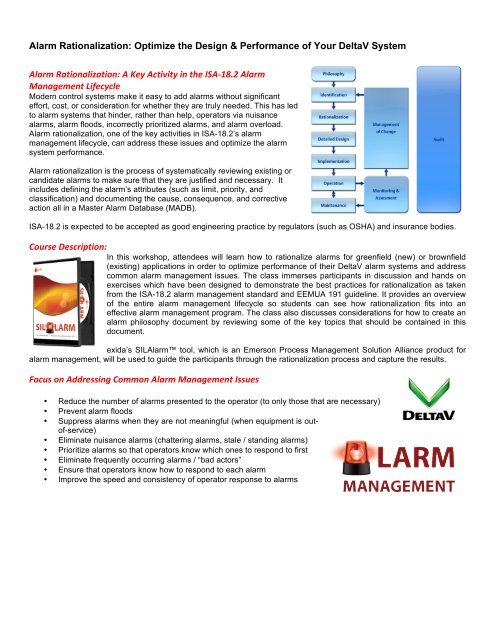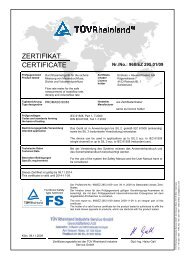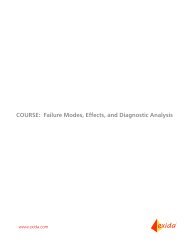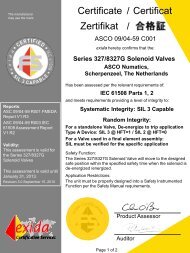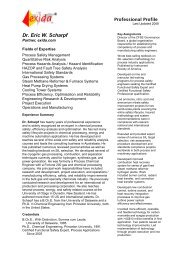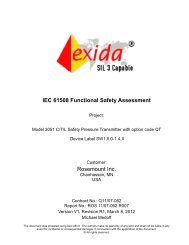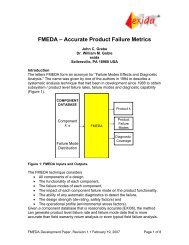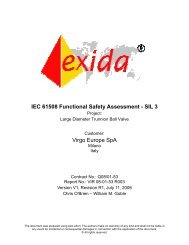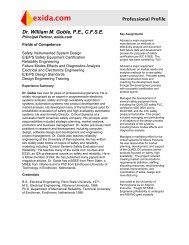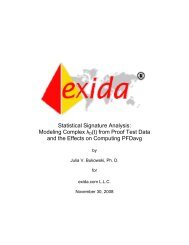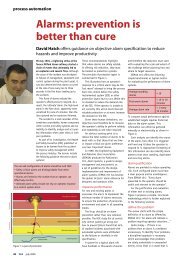Alarm Rationalization of DeltaV Systems - exida
Alarm Rationalization of DeltaV Systems - exida
Alarm Rationalization of DeltaV Systems - exida
Create successful ePaper yourself
Turn your PDF publications into a flip-book with our unique Google optimized e-Paper software.
<strong>Alarm</strong> <strong>Rationalization</strong>: Optimize the Design & Performance <strong>of</strong> Your <strong>DeltaV</strong> System<strong>Alarm</strong> <strong>Rationalization</strong>: A Key Activity in the ISA-‐18.2 <strong>Alarm</strong> Management Lifecycle Modern control systems make it easy to add alarms without significanteffort, cost, or consideration for whether they are truly needed. This has ledto alarm systems that hinder, rather than help, operators via nuisancealarms, alarm floods, incorrectly prioritized alarms, and alarm overload.<strong>Alarm</strong> rationalization, one <strong>of</strong> the key activities in ISA-18.2’s alarmmanagement lifecycle, can address these issues and optimize the alarmsystem performance.<strong>Alarm</strong> rationalization is the process <strong>of</strong> systematically reviewing existing orcandidate alarms to make sure that they are justified and necessary. Itincludes defining the alarm’s attributes (such as limit, priority, andclassification) and documenting the cause, consequence, and correctiveaction all in a Master <strong>Alarm</strong> Database (MADB).ISA-18.2 is expected to be accepted as good engineering practice by regulators (such as OSHA) and insurance bodies.Course Description: In this workshop, attendees will learn how to rationalize alarms for greenfield (new) or brownfield(existing) applications in order to optimize performance <strong>of</strong> their <strong>DeltaV</strong> alarm systems and addresscommon alarm management issues. The class immerses participants in discussion and hands onexercises which have been designed to demonstrate the best practices for rationalization as takenfrom the ISA-18.2 alarm management standard and EEMUA 191 guideline. It provides an overview<strong>of</strong> the entire alarm management lifecycle so students can see how rationalization fits into aneffective alarm management program. The class also discusses considerations for how to create analarm philosophy document by reviewing some <strong>of</strong> the key topics that should be contained in thisdocument.<strong>exida</strong>’s SIL<strong>Alarm</strong> tool, which is an Emerson Process Management Solution Alliance product foralarm management, will be used to guide the participants through the rationalization process and capture the results.Focus on Addressing Common <strong>Alarm</strong> Management Issues • Reduce the number <strong>of</strong> alarms presented to the operator (to only those that are necessary)• Prevent alarm floods• Suppress alarms when they are not meaningful (when equipment is out<strong>of</strong>-service)• Eliminate nuisance alarms (chattering alarms, stale / standing alarms)• Prioritize alarms so that operators know which ones to respond to first• Eliminate frequently occurring alarms / “bad actors”• Ensure that operators know how to respond to each alarm• Improve the speed and consistency <strong>of</strong> operator response to alarms
What Attendees will learn from the class: • Create an <strong>Alarm</strong> Philosophy Document that leverages the capabilities <strong>of</strong> the <strong>DeltaV</strong> system• Transfer alarm configuration settings to / from <strong>DeltaV</strong> via Bulk Edit (User Defined Format files)• Criteria for determining when an alarm is valid and necessary• Prioritizing alarms based on potential consequences and time to respond• Establishing alarm limits and evaluating operator response time• <strong>Alarm</strong> classification: how to do it and what to use the results for• Implement conditional alarming (hysteresis, on / <strong>of</strong>f delay) to eliminate chattering alarms• Configure <strong>Alarm</strong> Shelving to allow operators to manually suppress alarms on a temporary basis• Use <strong>of</strong> Advanced <strong>Alarm</strong>ing techniques (first-out alarming, state-based (static) suppression, alarm flood (dynamic)suppression, state-based alarming to ensure alarms are relevant and meaningful when presented to the operator• Use <strong>DeltaV</strong> Analyze to benchmark alarm system performance and identify rationalization goals / targets• Techniques for treating system / instrument diagnostic alarms (e.g. PV BAD alarms) and alerts• Implementing management <strong>of</strong> change (MOC) for the Master <strong>Alarm</strong> Database• Populate <strong>DeltaV</strong> <strong>Alarm</strong> Help / create <strong>Alarm</strong> Response Procedures from the rationalization results• Techniques for managing / ensuring a successful rationalization projectWho Should Attend: Those responsible for leading/facilitating alarm rationalization, maintaining the master alarm database, or configuring the<strong>DeltaV</strong> system based on the results <strong>of</strong> rationalization.What the Course Includes: • Course notes, SIL<strong>Alarm</strong> Users Manual / Best Practices Handbook• Two (2) weeks <strong>of</strong> online access to SIL<strong>Alarm</strong> after the class• SIL<strong>Alarm</strong> Master <strong>Alarm</strong> Database loaded with a representative portion <strong>of</strong> your <strong>DeltaV</strong> ConfigurationCourse Length: 2 daysInstructor Bio Todd Stauffer, PE, is responsible for marketing and business development <strong>of</strong> <strong>exida</strong>’salarm management products and services (training, consulting, engineering tools). He isthe product manager for SIL<strong>Alarm</strong> and has led its development working closely with theEmerson Process Management team. Todd is an editor and voting member <strong>of</strong> the ISA-18.2 standards committee on alarm management and currently is the co-chair <strong>of</strong> ISA-18.2’s Working Group 3 chartered with writing the Basic <strong>Alarm</strong> Design technical report.He is an instructor for ISA’s training class “Introduction to the Management <strong>of</strong> <strong>Alarm</strong><strong>Systems</strong>”. Todd has published and presented numerous papers on alarm management.


